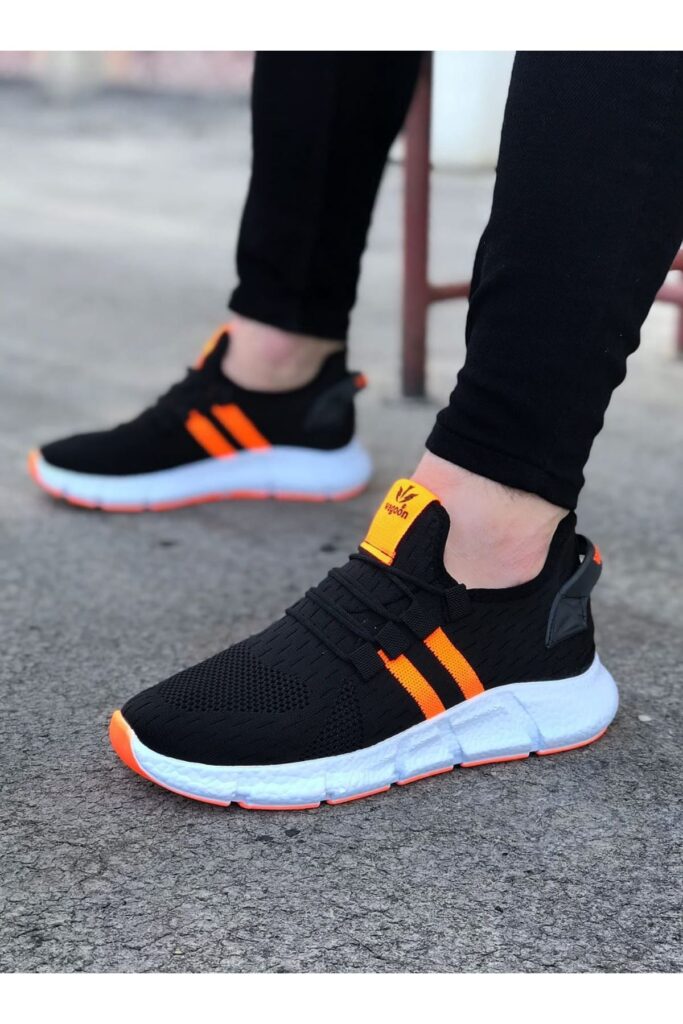Do you have plantar fasciitis and are looking for the best walking shoes? Plantar fasciitis can be painful, and finding the right type of shoes to minimise discomfort is important. In this ultimate buying guide, we’ll look at the factors to consider when shopping for best walking shoes for plantar fasciitis and provide some of the best products on the market. Learn more about picking the perfect pair of shoes to help you cope with plantar fasciitis!
Understanding Plantar Fasciitis and Its Impact on Walking
Plantar fasciitis is a common foot condition that can significantly impact your ability to walk comfortably. The plantar fascia is a thick band of tissue that runs along the bottom of your foot, connecting your heel to your toes. When this tissue becomes inflamed or irritated, it can cause sharp pain and stiffness, especially when walking or standing for long periods.
Walking can exacerbate plantar fasciitis because each step puts pressure on the affected area. This can make it difficult to enjoy daily activities or even complete simple tasks without experiencing discomfort. It’s important to understand plantar fasciitis’s impact on walking to find the right shoes that provide the necessary support and cushioning to alleviate pain and promote healing.
Types of Plantar Fasciitis Walking Shoes
When it comes to finding the best walking shoes for plantar-fasciitis, there are a few different types to consider. The first type is the stability shoe, which provides additional support and cushioning for your arches and heels. These shoes are designed to prevent over pronation and offer stability during each step. Another type to consider is the motion control shoe, which is ideal for those with severe over pronation.
These shoes have a stiffer sole and extra support to control the movement of your foot. Finally, cushioned shoes offer ample padding and shock absorption, perfect for those who need extra comfort and protection. No matter which type you choose, look for features like a supportive midsole, cushioned insole, and a wide toe box to accommodate any foot issues.
Key Features of Best Walking Shoes for Plantar Fasciitis
Finding the best walking shoes for plantar fasciitis involves considering several key features that can provide the support and comfort you need. One important feature to look for is a supportive midsole. A midsole with proper arch support and cushioning can help alleviate the pressure on your plantar fascia, reducing pain and promoting healing.
Additionally, a cushioned insole is essential for absorbing shock and providing extra comfort during your walks. Another feature to consider is a wide-toe box. This allows ample room for your toes to move and prevents added pressure on your foot’s front. Additionally, shoes with a wide toe box can accommodate foot issues like bunions or hammertoes.
Furthermore, choosing walking shoes with a supportive heel counter is important. A heel counter provides stability and prevents your foot from rolling inward, which can aggravate plantar fasciitis. Lastly, consider shoes with a breathable and lightweight upper material. This ensures proper airflow, keeping your feet cool and dry during your walks.
How to Choose the Right Size and Fit
When choosing the right size and fit for your plantar fasciitis walking shoes, there are a few important factors to consider. First and foremost, always measure your feet before making a purchase. This will ensure you get the correct size and prevent discomfort or pain from ill-fitting shoes. When trying on shoes, wear the socks you typically wear while walking to get an accurate fit.
Additionally, pay attention to the width of the shoe. Too narrow shoes can cause additional discomfort and aggravate your plantar fasciitis. Lastly, take the time to walk around in the shoes and ensure enough room in the toe box for your toes to move freely. Remember, the right size and fit are crucial for supporting and comforting your feet as you battle plantar fasciitis.
Tips for Maintaining Your Plantar Fasciitis Walking Shoes
Taking care of your plantar fasciitis walking shoes is crucial to ensure they last longer and continue to provide the support and comfort you need. Here are some tips for maintaining your shoes:
- Clean Them Regularly: Clean your walking shoes to remove dirt, sweat, and odour. Use a mild soap and water solution, gently scrub the shoes with a soft brush. Avoid using harsh chemicals or throwing them in the washing machine, which can damage the materials.
- Air Dry Them: Allow your shoes to air dry naturally after cleaning. Avoid direct heat sources like radiators or dryers, as excessive heat can cause the materials to warp or shrink.
- Use Shoe Inserts: Use shoe inserts or orthotics to provide additional support and cushioning for your plantar fasciitis. These can help reduce the strain on your foot and extend the lifespan of your shoes.
- Rotate Your Shoes: Alternate between two or more pairs of walking shoes. This allows each pair to dry out between uses fully, preventing moisture buildup and reducing the odour or bacterial growth risk.
- Replace Worn-Out Parts: Keep an eye on the condition of your shoes, including the midsole, insole, and outsole. If you notice significant wear and tear, it’s time to replace them. Worn-out shoes can worsen your plantar fasciitis and lead to further discomfort.
Breaking In Your Plantar Fasciitis Walking Shoes
Breaking in your plantar fasciitis walking shoes is important to ensure maximum comfort and support. While many shoes may feel great right out of the box, gradually breaking them in’s still necessary to prevent discomfort or blisters. Here are a few tips to help you break in your plantar fasciitis walking shoes effectively:
Start Slowly:
Start by wearing your new shoes for short periods, gradually increasing each day’s duration. This allows your feet to adjust to the shoes and minimises the risk of discomfort or injury.
Wear Them Around The House:
Instead of taking your new shoes for a long walk immediately, wear them for a few days. This will give your feet time to get used to the fit and feel of the shoes.
Use Socks And Insoles:
Wear thick or cushioned insoles in the beginning stages of breaking in your shoes. This provides additional padding and helps prevent friction and blisters.
Stretch The Shoes:
You can stretch them using various methods if your new shoes feel tight in certain areas. One popular technique is filling zip-lock bags with water and placing them in the shoes overnight. The water expands as it freezes, stretching the shoes slightly.
Listen To Your Feet:
Pay attention to any discomfort or pain during the breaking-in period. If you experience significant discomfort, it may be necessary to reconsider the shoes and explore other options that better suit your feet.
Alternative Treatments for Plantar Fasciitis Relief
When it comes to finding relief from plantar fasciitis, there are alternative treatments that can complement wearing the right walking shoes. While these treatments may not be a cure-all, they can provide additional relief and support to help manage your symptoms. One popular alternative treatment is physical therapy. A physical therapist can provide exercises and stretches to strengthen your feet’ muscles and ligaments, reducing pain and improving flexibility.
Another option is using orthotic inserts or custom orthotics. These devices can help provide additional support and cushioning to alleviate pressure on the plantar fascia. Additionally, some individuals find relief from plantar fasciitis through acupuncture or massage therapy. These treatments can help promote blood flow and reduce inflammation in the affected area.
Expert Tips for Shopping For Walking Shoes
Are you ready to hit the stores and find the perfect walking shoes for your plantar fasciitis? We’ve covered you with these expert tips to make your shopping experience a breeze.
Know Your Needs:
Before you start your shoe hunt, know what you’re looking for. Consider the level of support and cushioning you need and any specific foot issues you may have.
Seek Professional Advice:
Don’t be afraid to consult a podiatrist or orthopedic specialist who can guide you in choosing the right shoes for your plantar fasciitis. They can provide valuable insights and recommendations based on your individual needs.
Try Before You Buy:
When you’re at the store, take the time to try on multiple pairs of shoes. Walk around and see how they feel. Don’t be shy about asking for different sizes or styles until you find the one that fits perfectly.
Consider Customisation:
If you cannot find off-the-shelf walking shoes that meet your needs, consider getting custom orthotics or shoe inserts. These can provide personalised support and cushioning for your feet.
Don’t Compromise On Quality:
While it can be tempting to opt for cheaper shoes, investing in a high-quality pair is essential for long-term foot health. Look for reputable brands that specialise in walking shoes for plantar fasciitis.
Don’t Forget About Style:
Who says you can’t have both comfort and style? Look for walking shoes that offer the support you need and match your style. There are plenty of fashionable options out there.
FAQ’s
Q: Can walking shoes help with plantar fasciitis?
A: Absolutely! The right walking shoes can provide the necessary support and cushioning to alleviate pain and promote healing. Look for shoes with arch support, cushioned insoles, and a wide-toe box to accommodate your needs.
Q: Should I get stability shoes or motion-control shoes?
A: It depends on your level of over pronation. If you have mild over pronation, stability shoes should suffice. However, motion-control shoes with extra support and a stiffer sole may be better if you have severe over pronation.
Q: Can I wear orthotics or inserts with my walking shoes?
A: Definitely! Orthotics or inserts can provide additional support and cushioning, enhancing the comfort and effectiveness of your walking shoes. Consider getting custom orthotics for a personalised fit.
Q: How long do best walking shoes for plantar fasciitis last?
A: The lifespan of your best walking shoes for plantar fasciitis depends on factors like usage and maintenance. On average, walking shoes should be replaced every 300-500 miles or when you notice significant wear and tear.
Q: Can I wear stylish walking shoes for plantar fasciitis?
A: Absolutely! There are plenty of stylish options available that offer the support and comfort you need. Look for reputable brands specialising in walking shoes for plantar fasciitis to find fashionable choices.
Conclusion
In conclusion, finding the right walking shoes for plantar fasciitis minimises discomfort and promotes healing. You can find a pair of shoes that will provide the necessary relief by considering factors such as support, cushioning, and fit. Remember to maintain and break in your shoes properly to ensure longevity and effectiveness. Alternatively, treatments and expert tips can complement using walking shoes for plantar fasciitis. With the right pair of shoes and additional support, you can take steps towards managing your plantar fasciitis and enjoying pain-free walks once again.
| Other Good Articles to Read |
| Gabrielle Blogs |
| Jason Toff Blogs |
| Thumb Blogs |
| Blog Shifter |
| Free Blogs Template |
| Blog Solidaire |
| Michael Coyne Blog |
| Born Free Blog |
| Oz Blog Hosting |
| Indepth News |
| Link Forum |



